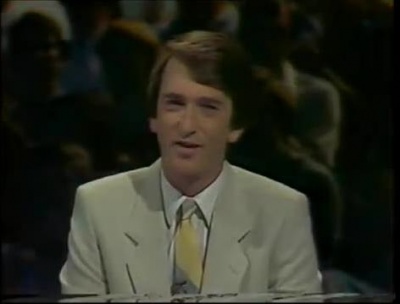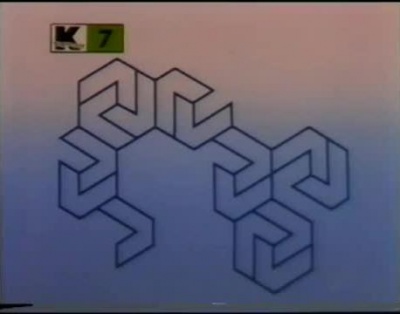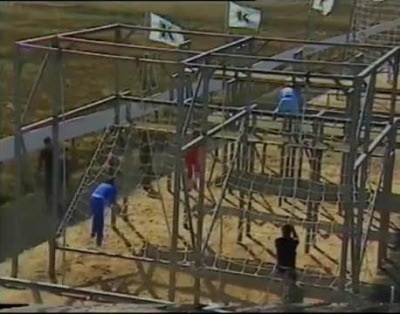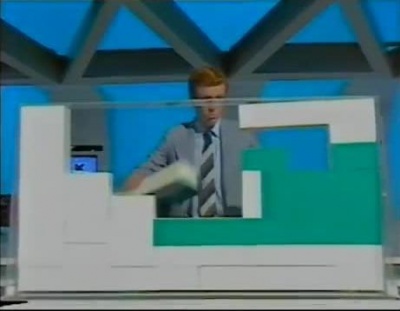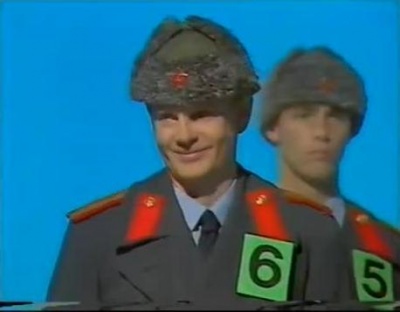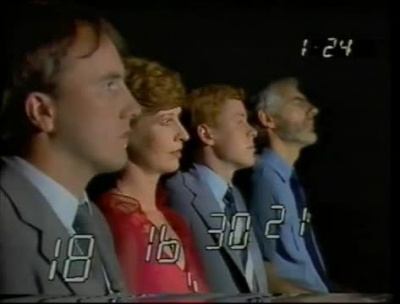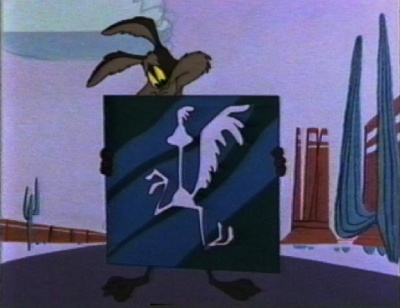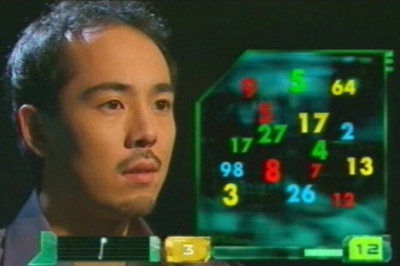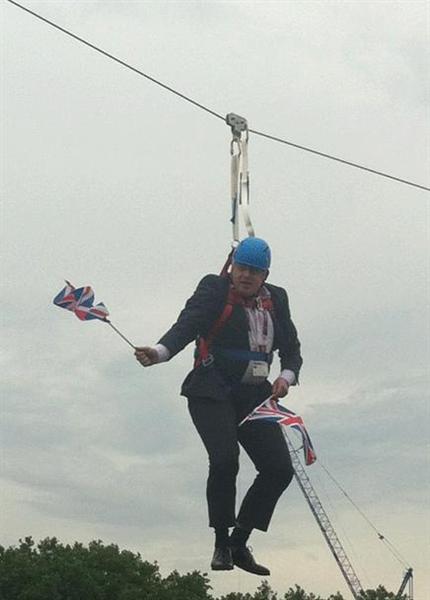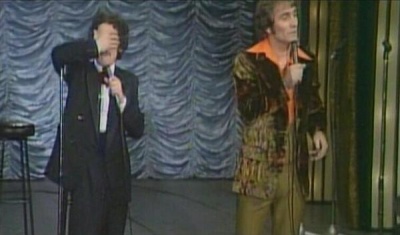Weaver's Week 2012-08-05
Last week | Weaver's Week Index | Next week
This week, we conclude our comparison of The Krypton Factor through the years.
Contents |
The Krypton Factor
Granada for ITV, 1984
Gordon Burns is the host, naturally, and he's deep into the search for the United Kingdom Superperson of Nineteen Eighty Four. The sample episode we've got is heat 11: if we remember the series structure correctly, the twelve heat winners, plus the four highest-scoring runners-up from across the series, progressed to the semi-finals, from where only the winners went to the final. We could be completely mis-remembering: it was a very long time ago.
The programme's introduced by a long computer-generated animation: it has representations of all the rounds, including a remarkably scary eye, and a few obstacles from the assault course. Only after 30 seconds do we get to begin the contestant biographies: name, age, occupation, location, all crisply voiced.
While Gordon explains the rules of the Mental Agility round, there's a close-up shot of each player, with a caption reminding us of their name. This is a very simple and very effective introduction, presenting information in a way the viewer can discard.
The round itself is a sequence of nine slides, each showing a geometric pattern. Each slide is accompanied a statement, given by the professional voiceover man. Only four of these statements are correct, and the contenders are to indicate which four those were. These statements are along the lines of, "there are more than fifteen identical shapes in this figure", or "there are not fewer than seventeen small rectangles in this figure." And the players must identify the identical shape, and count them, and not count non-identical shapes, and compare against the claim. And they must do this in about six seconds.
Once the test is over, and the contenders have locked in their answers, Gordon shows us the ones they should have picked, but doesn't go back and explain why the other ones were wrong. We're not entirely convinced that this was the best way to present the test for viewers. The contestants indicated their answers by pushing buttons on their chair arm, and these chosen numbers display on the column by them. Two points for each correct answer, a bonus two points for any contestant achieving perfection, so the traditional 10-6-4-2 scoring is still possible.
The Physical Ability round is shown next, filmed as ever with the assistance of the army. There are staggered starts – the female contender gets 30 seconds on the oldest man, who gets some time on the younger men. Gordon explains the course as we go, and how the errors in technique will cost the contenders. We note that the competitors wore tracksuits in red, and in three shades of blue. All the signature obstacles are there: the A-frame, the death slide, the crawl up a dark pipe, and the inverted V to a water jump, which one of our contenders almost clears.
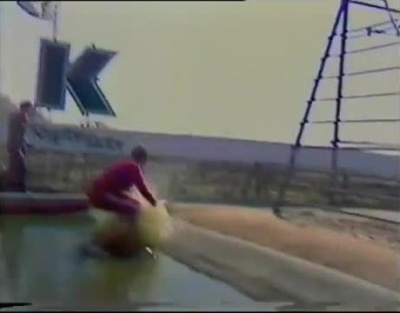 Splashdown for Pat Everitt. Note the original K-logo, very similar to the 2009 revival.
Splashdown for Pat Everitt. Note the original K-logo, very similar to the 2009 revival.
Gordon gives us a scare while introducing the Intelligence round, but then tells us "1984 was the year of the European elections." The challenge is to construct the original flag of the Council of Europe from a collection of pentominoes. Not that the CoE has anything to do with the EC, but we'll let that pass. Cue more shots of people trying to fit blocks into a frame, to form a pattern they don't quite know until they see it. As ever, Gordon explains what's going on, and it's all carefully edited into three minutes of television.
The Observation round is the reason why older editions of The Krypton Factor have rarely been repeated – they feature an edit from a recent movie release. While Granada will have cleared these clips for use at the time, we can be sure that the distributors would demand loads to show them now. Even though we've completely forgotten about Gorky Park*, the movie providing the clip for this week.
After a couple of minutes of action, the contenders are asked two questions each about details from the clip. "How many officers saluted?" or "What two words were used to describe the sergeant's father?" Two points for these assigned questions. Then there are four questions on the buzzers, each for a single point. These can be passed from person to person, when Gordon Burns says the one word "Wrong!"
The final part of the round is the identity parade. Nine people appear in a line-up, one of them is the actual actor from the movie, the other eight are ringers. Can the contestants spot the Russian detective from the Russian defectives? Two points for a correct answer, awarded when Gordon says, "Will the real civil police detective make himself known to the contestants now, please!"
It's Patrick Field, who will go on to play a policeman in Lovejoy, a policeman in Closing Ranks, a policeman in Between the Lines, and appear in The Bill. As a villain.
All of this brings us to the general knowledge round, 90 seconds of — hang on! This general knowledge round begins with three assigned questions for each player, on topics that become familiar as the round progresses. There was a slight advantage to going first in the observation round, because it was sooner after seeing the clip; there's a slight advantage to going last here, because the topics will be a bit better known. Two points per correct answer.
After this, we do have 90 seconds of quick-fire questions on the buzzers. One point for each correct answer, a point deducted for each incorrect one. At the end of this round, the person with the highest Krypton factor is the winner, and has the dubious honour of doing it all again in the next round.
We noted that all the gentlemen in the studio were wearing a suit and tie. It's not clear if this was a deliberate style choice, or if it was merely following the fashion of the era. What is certain is that the players weren't in any particular colour, nor in tracksuits as they would be in later series.
The Krypt-On Factor
MCA Enterprises / Alan Landsburg Productions for ABC (US), 1981
No such sartorial problems on this edition of The Krypt-On Factor, which is in such shockingly bad condition that we simply cannot present any pictures drawn directly from the show. The four contestants are introduced with name, age, location, and occupation, while running towards the camera very slowly. Have they been watching The Six Million Dollar Man (or its British equivalent, The Two and a Half Million Quid Chap)?
It's tracksuit tops for the contestants, who will spend the next twenty minutes standing behind podia. Host Dick Clark has turned up in black suit, white shirt, black bow-tie, as though he'd been taking wardrobe advice from a penguin. Unlike the UK version, this show is played for big prizes – gold to the value of $5000 (then £2000) for winning a show, and the four winners came back to win $50,000 of gold.
Another difference is how The Krypt-on Factor was mostly determined by individual challenges – "tests of physical and mental ability, pushing them to their limits". Round one, for instance, was the forerunner of the Response round. In the sample episode we've obtained, it's a short game of Space Invaders. At this early date (it is 1981), Dick Clark has to explain that the player moves their ship along the bottom of the screen, and the aliens fire back. Look, it was state of the art at the time. Score 25 points in twelve seconds and without losing two ships, and the player adds 5 to their Krypt-on Factor.
Round two is Mental Agility, a two-part test. Part one is a difference from ten – Dick will give five numbers, and the contender is to respond with their differences from ten. So when the host calls, "6 3 9 4 8", he's expecting to hear "4 7 1 6 2". And not "That's numberwang!" otherwise the contender won't pick up four points.
Nor will they play in the second phase of this round, which is only open to players who got their number question correct. Here, players are given a list of six historical figures, and must repeat them in reverse order. Six points for success, nothing for failure.
After the commercial break comes round three, Physical Ability. Again, it's proof that these Yankees don't quite understand the principles. They begin with the death slide, except it's not a death slide, it's a "slide for life". Whatever. Then there's a battle with an inflatable borrowed from Cheggers Plays Pop, a walk across some stepping stones linked by plank bridges, through some tubes. Then it's on to that great test of physical ability, driving a jet ski.
Yeah. Driving a jet ski. It's as if Sgt. Mjr. Prosser said to the contenders at the top of the A-frame, "After this, there's a rally car for you to drive, and we'll finish by landing a plane. What? You crashed that in Response? Oh." Anyway, after this non-physical jerk, the contenders are to sit on a swing and swing it until they crash through a door. They end the course by rolling an inflatable hamster wheel: two parallel circles, linked by a dozen or so struts, and the player goes in the middle to turn it and run to the finish.
Physical ability doesn't have a staggered start, apparently the course has been designed to be equally difficult for men and women. How they tested this, we've no idea. It's the only round where players go up against each other – 20 for the winner, reducing to 5 for the loser. Sorry, fourth-placed winner.
Round four, Observation, is a clip from a contemporary film – in this case, The Cannonball Run*. Two questions to each contender – a two-choice visual observation question for four points, and a specific dialogue question for six. Marking is strict, and the dialogue has to be precisely accurate to score. In a rather nifty move, the clip from the film is only repeated if the player's response is wrong, and Dick Clark doesn't acknowledge this re-showing in any way.
The round concludes with the identity parade – in this case, it's six ladies who might have been in a car with Roger Moore. Ten points if the contenders can spot the right blonde. Lois Areno, later known as Lois Hamilton, had a short but vibrant career, and died in 1999.
By then, the show will be long over. After the commercial break, it concludes with the final round, General Knowledge. Three minutes of rapid-fire questions, two points for a right answer, two away for an error. But there's more: half-way through the time, a noise will sound, and the points double: four points on or off. Whoever wins after this will win.
Looking back, we're actually rather taken by this format. Players are able to score 35 points on their own abilities, regardless of how well the opposition does. It's only the physical ability, and the general knowledge, where players are up against each other. This would be a very fair test, especially where qualification was to be on the best scores across a number of shows, rather than winning the night's heat. In short, this would have been good for the children's series we reviewed last week.
This Week And Next
Always quick on the draw, Countdown hosted its 2011 Grand Final this week, pitting June 2011 champ Edward McCullagh against the December winner Graeme Cole. Graeme began in the worst possible way, "Toadier" was disallowed – evidently the OED hasn't got enough citations like "Peter is even toadier towards the boss than Paul." Edward's lead extends in the third round, when he has the plural, PHONATES, to Graeme's singular. He gets the numbers round and all, ensuring that the lead is already a tennis score, 15-40. The anecdote is provided by Mark Foster, one of those people who is able to appear on two channels at once – he's live in Manchester, as the swimming on BBC1 was pre-recorded some weeks ago.
Nothing alters that lead during the second period, we're just in awe of people who know what ADIPATES are, still less when to use them. Edward is still on for a maximum game, but that ends with the second numbers round – his error allows Graeme to close the gap to 68-50. Straight afterwards, he puts the E in the middle of SIZEABLE, extending his lead even more sizeably. This column finally gets on the board in the final letters round, where we find PHREAK. Edward adds the conundrum, and has wrapped up the win, 107-71.
In international news, we learn that the Golden Rose of Montreux is to move. The whole industry festival has been bought up and will move to Brussels. Somehow, we don't think the phrase "The Great British Bake Off has won the Golden Sprout of Belgium" has quite the same ring to it.
There are going to be more local versions of that prize-winning show: The Great Australian Barbie-Off and Wielka Polacy Piekarnia Ryzyko could be hosted by Sheila Perkins and Mel Giedroyc, respectively.
Ratings in the week to 22 July show the top game show was Secret Fortune, with 4.3m people seeing the show. ITV's best was Dancing on Ice Goes Gold (3.8m), comfortably ahead of Superstar (week's best: 2.85m). University Challenge slipped back in to the top of BBC2, with 2.15m viewers; Come Dine with Me led on C4 (1.8m) and Big Brother had 1.6m on Channel 5.
Elsewhere, Come Dine With Me scored well for More4, 625,000 saw the Sunday repeat. Hell's Kitchen Us brought 610,000 to ITV2, and 470,000 saw Britain and Ireland's Next Top Model on UK Living. We never knew Blankety Blank was so popular, repeats there brought 165,000 to Challenge.
Another quiet week: we've new runs of Just a Minute (Radio 4, 6.30 Monday) and Mastermind (BBC2, 8pm Friday), and another chance to hear The Unbelievable Truth (Radio 4xtra, 9.30am Thursday).
To have Weaver's Week emailed to you on publication day, receive our exclusive TV roundup of the game shows in the week ahead, and chat to other ukgameshows.com readers, sign up to our Yahoo! Group.


